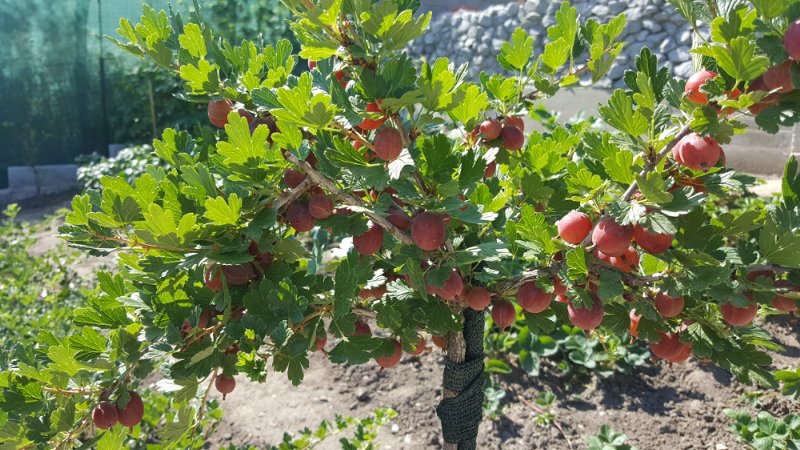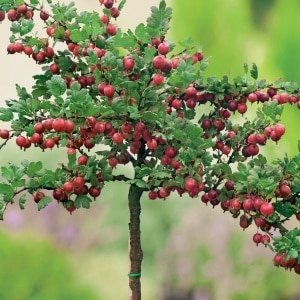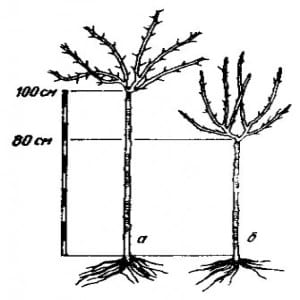Growing gooseberries on a trunk
Standard plantings are gaining popularity due to a number of advantages: they are easier to care for, they are less susceptible to diseases, and the berries grow larger and tastier. The shrub on a trunk looks original and decorates the garden plot.
When planting standard gooseberries, it is important to take into account that its cultivation requires certain knowledge, effort and time. Let's consider its main advantages and features of agricultural technology.
Description of gooseberries on a trunk
Gooseberry is a spreading shrub that grows over time. It makes it difficult caring for him, tillage, harvesting, contributes to the development of various diseases. The standard method of growing crops avoids these problems.
What does it look like

A berry crop on a trunk is a tree with a height of 0.6 to 1.5 m. The height of the plant depends on the growing method. Falling branches and foliage form a cap on the even trunk.
Reference. Stamb (German) Stamm— "trunk") - part of a tree trunk from the root collar to the first skeletal branch of the lower tier of the crown.
The shape of the gooseberry is determined by pruning. The roots of the bush are shallow and shallow, so additional supports are used for stability.
Advantages and disadvantages
Gardeners leave a lot of positive reviews about gooseberries on a trunk, highlighting the advantages of this growing method:
- the bush is more compact and takes up little space on the site;
- easier to care for, fertilize, loosening and watering;
- the crown is well ventilated and illuminated, as a result the plant is less susceptible to various diseases;
- branches do not break under the weight of snow;
- productivity increases, fruit larger and sweeter;
- more convenient to pick berries;
- Gooseberries on a trunk decorate the plot.
Disadvantages of such landings:
- seedlings are more expensive than ordinary ones;
- only winter-hardy varieties are used;
- gooseberries require constant support and additional protection from frost;
- the harvest depends on one shoot;
- it is important to periodically remove root growth;
- The shrub is demanding when it comes to feeding.
How to grow standard gooseberries

To breed a standard bush, varieties are used that form few shoots and weakly branch. The most popular include Shchedry, Russian, Salyut, Amber, Redball, Kolobok, Yarovoy, and Ural grapes. To grow gooseberries on a trunk, 2 methods are used:
- the bush is formed on its own roots, using tools for trimmings;
- grafting onto the rootstock.
To prevent the standard gooseberry from breaking, a supporting structure is used throughout the life of the plant. A wooden stake, which is impregnated against rotting, or a metal profile is suitable for this. They are dug into the planting hole. If gooseberries are planted in rows, they are tied to an installed trellis in the middle of the trunk and the center of the crown.
Since the cost of standard gooseberry seedlings is high, many gardeners form the bush with their own hands.
By grafting method

To grow a standard crop using grafting, a scion is first prepared. Cut cuttings from a varietal bush, remove thorns. They are stored in damp sand, sawdust or peat at a temperature of about +3°C.
Gardeners recommend using golden currant seedlings as a rootstock (standard). They are distinguished by a powerful root system, produce little root shoots, are frost-resistant and durable.
The rootstock is planted in advance. Forcing is carried out not with a bush, but with a vertical shoot. In addition to golden currants, yoshta (a hybrid of black currant and gooseberry) is used as a rootstock. It is distinguished by smooth, strong shoots and frost resistance. One shoot is left at the trunk. The side ones are pinched to thicken the trunk.
Reference. Annual or biennial plants are used as stems.
Gooseberries are grown in standard (height of the grafting site - 60–100 cm) and semi-standard (height - 40–60 cm) form. Vaccination is carried out in the spring, when sap flow begins. How to graft gooseberries:
- in a split - with different diameters of the scion and rootstock;
- improved copulation - when the slice sizes are the same;
- in a butt with a tongue - when the scion and rootstock are of different sizes;
- in the side cut - for different varieties.
The grafted plants are watered and shaded. Young shoots are removed from the trunk. In autumn, the shrub is transplanted to a permanent place. A stake is installed in the planting hole, to which the bush is tied at the grafting site. New shoots on the trunk are periodically cut off. Spring and autumn plant trimmed, directing the branches in the right directions, and giving the crown the required shape.
Shaping by trimming

In this case, the lateral branches of the gooseberry grown on its own roots are pruned and shortened, while maintaining the central conductor. This is a simpler method, accessible even to novice gardeners.
Reference. If the shape is not satisfactory, a return to the classic bush is possible. To do this, leave root shoots at its base.
First, gooseberries are planted in a permanent place, usually in the fall. For formation, varieties with thick and dense shoots are selected. After the culture takes root, a strong, upright shoot is selected and left. The rest are cut at ground level.
Then they “blind” the abandoned shoot. To do this, remove all the buds from its lower part, leaving only 4-5 pieces at the top. In the first and second years of the plant’s life, the shoots that have developed from the buds are cut in half to create the correct shape. In subsequent years, they are not shortened, but older, fruit-bearing, damaged and diseased branches are removed. The growths that appear on the trunk and near it are periodically trimmed.
Planting gooseberries on a trunk

Gooseberries love air, light and space. Therefore, it is planted in a sunny place, in moist and fertile soil with an acidity level pH 6.0–6.8. A distance of at least 1 m is maintained between the bushes. Low-lying and swampy areas where water stagnates, and places with heavy chalky or sandy soil are not suitable for the crop.
The bush gets along well next to red currants and tomatoes. It is not recommended to plant the crop next to raspberries, black currants and wheatgrass, as they have common pests.
Favorable time for planting
Autumn is considered a favorable time for planting gooseberries on a trunk. The bush is planted in early spring, but there is a risk of its death, since during the summer heat the soil becomes dry and the roots do not have time to take root.
Landing rules
Step-by-step landing algorithm:

- The area is dug up, removing weeds and stones. Dig a planting hole. It should be 2 times larger than the roots of the plant. The excavated soil is mixed with rotted manure or compost in equal proportions.
- The roots of the plant are shortened slightly so that new young roots are formed at the cutting point. It is advisable to dip them in a solution of a root formation stimulator.
- The branches that thicken the trunk are cut off, the rest are shortened. The top of the gooseberry is not touched.
- A support system (stake or metal profile) is dug into the planting hole, a seedling is placed in the center, and the roots are straightened. Cover everything with soil mixture and compact it.
- The plant is well watered and the soil is covered with mulch.
- Gooseberries are tied to a support system in the middle of the trunk and crown.
To increase the yield, quality and taste of berries, it is recommended to plant several varieties on the site.
Caring for standard gooseberries
Standard plantings require more careful attention.
Watering
Gooseberries are drought-resistant crops, but regular watering, especially during the flowering period, ensures a good harvest. It is carried out at least once a week when the plant is blooming, the rest of the time - once every 2 weeks. Watering is important for young plants in hot and dry weather. In this case, it is carried out more often than on ordinary days, as the soil dries out. The water consumption rate for 1 bush is 50 liters.
Loosening and mulching the soil
To protect the roots from overheating in the heat, retain moisture in the soil, reduce the growth of weeds, and provide the crop with nutrients, the soil is periodically loosened and mulched. Sawdust, peat, mown grass and straw are used as mulch.
Fertilizers and fertilizers
During planting, organic fertilizers in the form of rotted manure or compost are added to the soil. In the spring, organic products are also used to provide gooseberries with nutrients.To do this, the soil around the bush is mulched with rotted manure, but so that it does not get on the stem.
Advice. If the plant develops slowly or is weakened, re-feed in the summer.
The shrub needs potassium and nitrogen. Annually add 100–200 g of nitrogen and 15 g of potassium per 1 m². If the soil is acidic, dolomite complexes are used, which normalize the balance of magnesium and calcium.
Trimming
To form the correct shape of a standard bush, it is pruned. At the same time, powerful shoots that are inconveniently or unsightly located are removed. Remove old and damaged branches. Depending on the method of growing gooseberries on a trunk, pruning varies.
If gooseberries are grown by grafting, at the end of the first or second season (this depends on the growth strength of the bush), it is formed from a central branch and 4–6 around. The rootstock is cut off above the bud by ¼ of the seasonal growth. The side branches are shortened, giving the plant a spherical shape. Subsequently, 4 branches are left, which are shortened by 20 cm every year. Old, weak and problematic shoots are also removed. When pruning, shoots aged from 1 to 3 years are preserved, older branches are removed. Thus, in 5 years, a gooseberry of the required shape is formed, which bears fruit for 7 to 10 years.
When a bush is formed on its own roots, after rooting, 1 shoot is selected. The remaining shoots are cut to ground level. All lower buds are removed from the shoot, leaving only the top 4-5 pieces. In subsequent periods, the lateral branches are shortened, leaving 4 branches on them. As a result, a spherical shape is formed. As the crop grows, old and damaged branches are cut off and the growth around is removed.
Support
To prevent the gooseberries from breaking, use a support system that is installed on the wind side. This can be a wooden stake or a metal profile. The wooden support is cleared of bark, treated with impregnation so that it does not rot, and painted. The gooseberries are tied to a peg at the level of the crown and in the middle of the trunk.
Preparing for winter
Gooseberries are a winter-hardy and frost-resistant crop. However, if the winter in the region is harsh and there is little snow, it is better to plant it under the protection of buildings. During the cold period, it is recommended to increase the layer of mulch around the trunk, hill it up and cover it with spruce branches.

Conclusion
Gooseberries on a trunk take up less space, are more convenient to care for and harvest, and the plant decorates the area. Growing a standard crop yourself requires some effort. If there is no time for this, ready-made seedlings are bought in special nurseries.